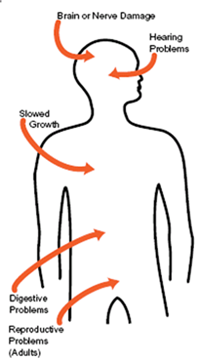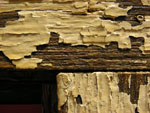Living Room
Hazards commonly found in living areas include lead, carbon monoxide (CO) and fire hazards. Visit the basement to learn more about carbon monoxide and fire safety.
Lead Poisoning

Lead is a toxin that can be found throughout the home. It affects all organs of the body, and it gets into the body through inhalation (breathed in) or ingestion (eaten).
Children are most vulnerable to lead poisoning because they naturally spend a lot of time on the floor (where lead dust is found), often stick their hands in their mouths, and are still developing (developing bodies absorb more nutrients from food than developed bodies). Although most children don't show signs of lead exposure at low levels, there is no safe level of lead. Signs at higher levels of exposure can include aggression, muscle spasms and inability to pay attention. The health effects of lead are PERMANENT and can include:
- Lower IQ
- Aggression or Hyperactivity
- Organ damage
- Difficulty paying attention
Lead Paint

Lead in paint was banned in the U.S. in 1978. Most homes built before 1978 are therefore likely to contain lead paint. Even some homes built after 1978 could contain it. When lead paint begins to deteriorate, it looks flaky (like alligator skin) and can fall off the walls. But lead paint chips aren't the only lead paint hazard...friction (like the opening of doors or windows) creates dust that can contain lead - even if the paint is covered by non-leaded paint! Leaded dust can then accidentally be inhaled or ingested by people.
Other Lead Hazards in the Home
Lead can also be found in soil outside the home, in some jewelry, toys, home remedies, ceramics and even some candies. It can also be found in drinking water. Although the amount of lead in water is closely regulated, many homes have lead in the pipes that can contaminate water. If you are unsure whether your pipes have lead or not, it is safest to always use cold water and run the faucet for about 15 seconds before using it. This will flush out water that has been standing in the pipes collecting lead.
What can I do to protect my family from lead?
- Get your child tested for lead. By law, all children must be tested at age 1 and 2.
- Use "Lead Safe Cleaning Techniques"
- Wash window sills and floors weekly
- Work wet.
- Use a HEPA filtered vacuum to clean up lead dust.
- Wash children's hands and toys with soap and water frequently.
- Keep children away from porches, windows and basements with cracking or peeling paint.
- Cover bare soil with grass or a thick layer of mulch.
- Know the Rochester Lead Law - renters in the City of Rochester may contact their local Neighborhood Services Center for a FREE lead inspection.
- As of April 2010, the federal Renovation, Repair and Painting Rule (RRP) requires professionals who disturb paint in homes, child care facilities and schools to be certified under the RRP guidelines.
- If your home was built before 1978, hire an RRP certified contractor, or use Lead Safe Work Practices when doing your own work. When in doubt, assume there's lead!
- Landlords can apply for a grantthrough the City of Rochester to reduce lead hazards.
Resources
For the most up-to-date resources, check out the Healthy Homes Resources page.